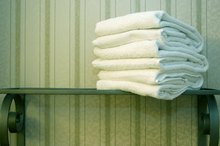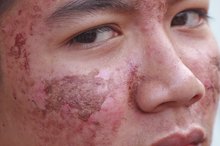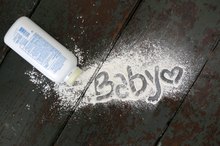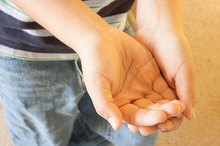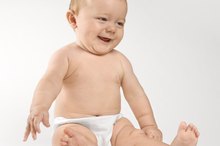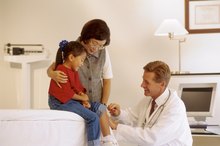What Can Cause Sudden & Severe Itchy Feet in a Child?
Your child takes his shoes off to scratch an itch, which was a big mistake because now his feet are burning. Athlete’s foot, which is likely causing your child's itchy feet, does not only affect adults 3. However, scabies also causes an intense itch. Consult with your child’s doctor for a proper diagnosis and treatment of his symptoms.
If you are experiencing serious medical symptoms, seek emergency treatment immediately.
Identification
If your child scratches an itch on his foot from athlete‘s foot and scabies, then the itch immediately becomes more noticeable and severe 3. An itch from athlete‘s foot often occurs between your child‘s toes and on the soles of his feet 3. The areas that your child scratches become raw and dry. Redness, skin peeling and a bad odor are often present with athlete’s foot 3. Scabies causes a pimple-like skin rash accompanied by severe itching. Scabies rarely occurs on the feet of older children, but it is seen on very young children — especially if the child is in daycare.
Cause
Itchy Skin Between the Toes
Learn More
Athlete’s foot is caused by a mold-like fungus that thrives in warm, damp areas such as your child’s sweaty sneakers or boots 3. This fungus is normally found on your child’s skin, but an overgrowth causes athlete’s foot 3. The fungus that causes athlete’s foot is contagious and is easily spread in public areas where people are regularly barefoot, such as locker rooms and public pools 3. Scabies are caused by microscopic mites that burrow into the top layers of your child’s skin and lay eggs to infest your child’s skin. Scabies is usually spread by prolonged skin-to-skin contact, but it can also occur from sharing bedding, towels, clothing or shoes with an infected person.
- Athlete’s foot is caused by a mold-like fungus that thrives in warm, damp areas such as your child’s sweaty sneakers or boots 3.
Treatment
Athlete’s foot can usually be treated at home with an over-the-counter antifungal medication 3. While your child uses this medication, it’s important that her feet stay clean and dry. Always apply the medication to clean feet. If possible, have your child go barefoot as often as possible or wear sandals that easily allow ventilation to the feet. If the itchiness is not responding to over-the-counter medications, a prescription strength topical or oral medication is necessary. Scabicides are available by prescription to kill scabies mites and scabies eggs. All members of the household should also be treated for scabies and the bedding, clothing and towels need machine washed and dried on the hottest settings.
- Athlete’s foot can usually be treated at home with an over-the-counter antifungal medication 3.
- If the itchiness is not responding to over-the-counter medications, a prescription strength topical or oral medication is necessary.
Prevention
Jock Itch in Children
Learn More
Have your child wear flip-flops in public showers, pools and locker rooms. You can control fungal growth by sprinkling anti-fungal powder on your child’s feet and shoes. Do not buy used shoes for your child or allow him to share shoes with friends or other family members. Your child should change his socks at least twice per day to keep moisture off his feet.
- Have your child wear flip-flops in public showers, pools and locker rooms.
Related Articles
References
- Center for Disease Control and Prevention: Parasites-Scabies
- MayoClinic.com: Athlete’s Foot
- Homei A, Worboys M. Fungal Disease in Britain and the United States 1850–2000: Mycoses and Modernity. Basingstoke (UK): Palgrave Macmillan; 2013. Chapter 2, Athlete’s Foot: A Disease of Fitness and Hygiene. Available from: https://www.ncbi.nlm.nih.gov/books/NBK169220/
- InformedHealth.org [Internet]. Cologne, Germany: Institute for Quality and Efficiency in Health Care (IQWiG); 2006-. Nail fungus: Overview. 2015 Jan 14 [Updated 2018 Jun 14].Available from: https://www.ncbi.nlm.nih.gov/books/NBK279547/
- InformedHealth.org [Internet]. Cologne, Germany: Institute for Quality and Efficiency in Health Care (IQWiG); 2006-. Athlete's foot: Overview. 2015 Jan 14 [Updated 2018 Jun 14].Available from: https://www.ncbi.nlm.nih.gov/books/NBK279549/
- Nigam PK, Saleh D. Tinea Pedis. [Updated 2019 Nov 25]. In: StatPearls [Internet]. Treasure Island (FL): StatPearls Publishing; 2019 Jan-. Available from: https://www.ncbi.nlm.nih.gov/books/NBK470421/
- Abd Elmegeed AS, Ouf SA, Moussa TA, Eltahlawi SM. Dermatophytes and other associated fungi in patients attending to some hospitals in Egypt. Braz J Microbiol. 2015;46(3):799–805. doi:10.1590/S1517-838246320140615
- Homei A, Worboys M. Fungal Disease in Britain and the United States 1850–2000: Mycoses and Modernity. Basingstoke (UK): Palgrave Macmillan; 2013. Chapter 2, Athlete’s Foot: A Disease of Fitness and Hygiene.
- InformedHealth.org [Internet]. Cologne, Germany: Institute for Quality and Efficiency in Health Care (IQWiG); 2006-. Nail fungus: Overview. 2015 Jan 14 [Updated 2018 Jun 14].
- InformedHealth.org [Internet]. Cologne, Germany: Institute for Quality and Efficiency in Health Care (IQWiG); 2006-. Athlete's foot: Overview. 2015 Jan 14 [Updated 2018 Jun 14].
- Nigam PK, Saleh D. Tinea Pedis. [Updated 2019 Nov 25]. In: StatPearls [Internet]. Treasure Island (FL): StatPearls Publishing; 2019 Jan-.
- Leyden JJ, Kligman AM. Interdigital athlete's foot: new concepts in pathogenesis. Postgrad Med. 1977;61(6):113-6.
- Blutfield MS, Lohre JM, Pawich DA, Vlahovic TC. The Immunologic Response to Trichophyton Rubrum in Lower Extremity Fungal Infections. J Fungi (Basel). 2015;1(2):130–137. doi:10.3390/jof1020130
- Al Hasan M, Fitzgerald SM, Saoudian M, Krishnaswamy G. Dermatology for the practicing allergist: Tinea pedis and its complications. Clin Mol Allergy. 2004;2(1):5. Published 2004 Mar 29. doi:10.1186/1476-7961-2-5
- Chollet A, Cattin V, Fratti M, Mignon B, Monod M. Which Fungus Originally was Trichophyton mentagrophytes? Historical Review and Illustration by a Clinical Case. Mycopathologia. 2015;180(1-2):1-5. doi:10.1007/s11046-015-9893-2
- Newland JG, Abdel-Rahman SM. Update on terbinafine with a focus on dermatophytoses. Clin Cosmet Investig Dermatol. 2009;2:49–63. Published 2009 Apr 21. doi:10.2147/ccid.s3690
- Hainer BL. Dermatophyte infections. Am Fam Physician. 2003;67(1):101-8.
- Jimenez-garcia L, Celis-aguilar E, Díaz-pavón G, et al. Efficacy of topical clotrimazole vs. topical tolnaftate in the treatment of otomycosis. A randomized controlled clinical trial. Braz J Otorhinolaryngol. 2019.
- Lestner J, Hope WW. Itraconazole: an update on pharmacology and clinical use for treatment of invasive and allergic fungal infections. Expert Opin Drug Metab Toxicol. 2013;9(7):911-26.
Writer Bio
Melissa McNamara is a certified personal trainer who holds a Bachelor of Arts in journalism and communication studies from the University of Iowa. She writes for various health and fitness publications while working toward a Bachelor of Science in nursing.

